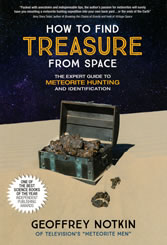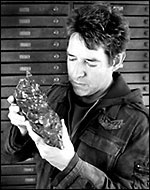Home » Meteorites » Iron Meteorites
 Illustration by Timothy Arbon
Illustration by Timothy Arbon
IRON METEORITES
THE HEARTS OF LONG-VANISHED ASTEROIDS
The sixth in a series of articles by Geoffrey Notkin, Aerolite Meteorites
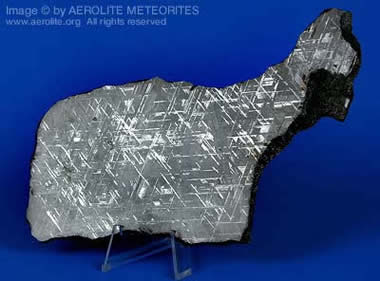
Gibeon slice: A large polished end cut of the Gibeon (IVA), fine octahedrite iron, first discovered in 1836 in the Namib Desert, Namibia. Gibeon is prized by collectors for its beautiful etch pattern, and popular with jewelers as it is a very stable iron and not prone to rusting. Small sections of the Gibeon irons are sometimes fashioned into rings and have been used to adorn the faces of expensive watches. Photograph by Leigh Anne DelRay, copyright Aerolite Meteorites. Click to enlarge.
In the second episode of Meteorwritings, "Meteorite Types and Classification," we reviewed the three main types of meteorites - irons, stones, and stony-irons. This month, and in the next two installments, we will take a much more detailed look at these classes, discuss how they were formed, what is unique about them, and also examine some well known examples of each type.
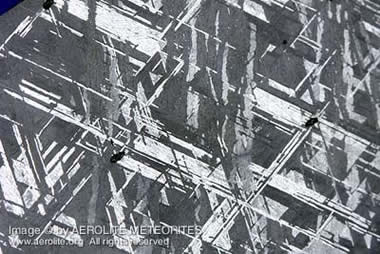
Gibeon slice detail: Detail of a Gibeon iron slice, after etching with a mild solution of nitric acid. Note the intricate pattern of taenite and kamacite bands. In etched sections of Gibeon, these bands are typically about 1 mm wide, or less, hence its designation as a fine octahedrite. Gibeon is one of the largest known meteorite falls with an estimated total recovered weight of 26 metric tons. Many of the largest known pieces are on display in Windhoek, the capital of Namibia. Photograph by Leigh Anne DelRay, copyright Aerolite Meteorites. Click to enlarge.
Where Do Iron Meteorites Come From?
In the classic 1959 adventure film, Journey to the Center of the Earth, based on Jules Verne's wonderful book Voyage au Centre de la Tèrre, a team of explorers led by a very proper and resourceful James Mason, encounter giant reptiles, vast underground caverns, oceans and the remains of lost civilizations in a subterranean world hidden far beneath our planet's crust.
If we actually could make such a journey to the Earth's center, our real-life adventure would be a rather short one, as the core of our planet is a sphere of molten iron with a temperature in excess of 4,000°C. The world imagined by Verne makes for a more exciting film, but without molten planetary cores we would not have iron meteorites.
Astronomers believe that in the early days of our Solar System, more than four billion years ago, all of the inner planets had molten cores. As our Earth is the largest of the Terrestrial planets (those composed largely of silicate rocks, as opposed to gaseous planets) it likely has a higher internal temperature than our smaller neighbors: Mars and Mercury.
We also know that at least some asteroids in the Asteroid Belt between Mars and Jupiter once had molten cores, and these bodies were the parents of iron meteorites. Their cores are believed to have been heated by radioactive elements and to have reached temperatures around 1,000ºC. The eminent meteoriticist Dr. Rhian Jones of the Institute of Meteoritics in Albuquerque succinctly explains the result:
"In a melted asteroid, melted rocky material and melted metal do not mix. The two liquids are like oil and water and stay separate. Metal is much denser than the rocky liquid, so metal sinks to the center of the asteroid and forms a core."
This liquid metal consisted largely of iron and nickel, which cooled very slowly over a period of millions of years, resulting in the formation of a crystalline alloy structure visible as the Widmanstätten Pattern [see below] in iron, and some stony-iron, meteorites that have been sectioned and etched.
A catastrophic event that led to the destruction of some of these asteroids - such as a collision with another substantial body - scattered iron-nickel fragments into space. Occasionally these fragments encounter our planet and hurtle, melting, through our atmosphere. Those that survive and land upon Earth's surface are iron meteorites.
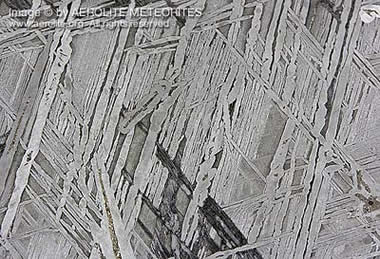
Glorieta slice detail: Detail of a slice from the Glorieta Mountain meteorite discovered in Santa Fe County, New Mexico in 1884. Both pallasites and siderites (irons) have been found in the same strewnfield. Note the complex interlocking pattern of iron-nickel bands. The area pictured is approximately 12 cm in width. Photograph by Leigh Anne DelRay, copyright Aerolite Meteorites. Click to enlarge.
How Do We Know They Are Real Meteorites?
One of the questions I am most frequently asked is: "How do we know they are real?" An experienced meteorite researcher, hunter, or collector can usually identify a genuine iron meteorite just by looking at it and holding it.
While melting in our atmosphere, iron meteorites typically acquire small oval shaped depressions on their surfaces known as regmaglypts. These features are not found on earth rocks. Iron meteorites are very dense - much heavier than almost all terrestrial rocks - and will easily adhere to a strong magnet. Iron meteorites also contain a relatively high percentage of nickel - a metal very rarely found on Earth - and they display a unique feature that is never seen in terrestrial material.
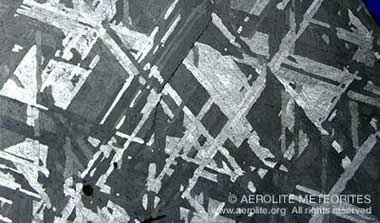
Henbury slice detail: The Henbury iron meteorite from central Australia is associated with a large crater field, and was first discovered in 1931. Henbury is classed as a IIIAB iron and is a medium octahedrite. The bands are considerably wider than of the Gibeon iron (fine octahedrite), also pictured on this page. Area shown is approximately 8 cm in width. Photograph by Leigh Anne DelRay, copyright Aerolite Meteorites. Click to enlarge.
The Widmanstätten Pattern In Iron Meteorites
In the early 1800s, a British geologist remembered only as "G" or possibly "William" Thomson discovered a remarkable pattern while treating a meteorite with a solution of nitric acid. Thomson was attempting to remove oxidized material from a specimen of the Krasnojarsk pallasite. After applying the acid, Thomson noticed a lattice-like pattern emerging from the matrix. The same effect was also noted by Count Alois von Beckh Widmanstätten in 1808, and is today best known as the Widmanstätten Pattern, but is sometimes also referred to as the Thomson Structure.
The intricate pattern is the result of extremely slow cooling of molten asteroid cores. The interlocking bands are a mixture of the iron-nickel alloys taenite and kamacite. My colleague Elton Jones explains:
"Nickel is slightly more resistant to acid than is iron so the mineral taenite doesn't etch as fast as kamacite, thus permitting the inducement of the Widmanstätten Pattern. Coarseness is an indication of the length of time the crystal growing process was allowed to run within the body of the asteroid. Growth of both mineral plates occurs so long as the temperature remains above 400°C and below 900°C. Generally this process is measured in declines of tens of degrees C per million years."
Since Widmanstätten Patterns cannot form in earthbound rocks, the presence of this structure is proof of meteoric origin.
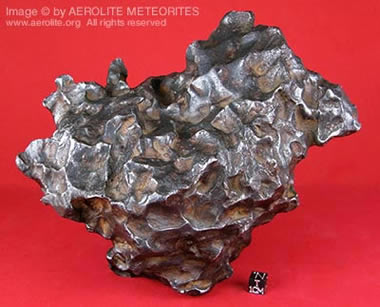
Sikhote-Alin iron meteorite: A spectacular example of the Sikhote-Alin iron meteorite, which fell in eastern Russia in 1947. This large specimen weighs 11.1 kg / 24 1/2 lbs and is described as a complete individual, as opposed to shrapnel specimens which are angular as a result of explosive fragmentation in the atmosphere. The scale cube pictured, is 1 cm in size. Note the sculptural shape and abundant regmaglypts (thumbprint-like indentations), caused when the surface melted during flight. Photograph by Leigh Anne DelRay, copyright Aerolite Meteorites. Click to enlarge.
| More About Meteorite Identification |
| If you would like to learn more about meteorite identification, and discover how to perform some other simple tests at home, please visit The Aerolite Guide to Meteorite Identification. Meteorites are very valuable both to the scientific community and to enthusiastic collectors. So, if you think one landed in your backyard, be sure to get it checked out! |
Classification of Iron Meteorites
Iron meteorites typically consist of approximately 90 to 95% iron, with the remainder comprised of nickel and trace amounts of heavy metals including iridium, gallium and sometimes gold. They are classified using two different systems: chemical composition and structure. There are thirteen chemical groups for irons, of which IAB is the most common. Irons that do not fit into an established class are described at Ungrouped (UNGR).
Structural classes are determined by studying the two component alloys in iron meteorites: kamacite and taenite. The kamacite crystals revealed by etching with nitric acid are measured and the average bandwidth is used to determine the structural class, of which there are nine, including the six octahedrites. An iron with very narrow bands, less than 1mm, (example: the Gibeon iron from Namibia) is described as a fine octahedrite.
At the other end of the scale is the coarsest octahedrite (example: Sikhote-Alin from Russia) that may display a bandwidth of 3 cm or more. Hexahedrites exhibit large single crystals of kamacite; ataxites have an abnormally high nickel content; plessitic octahedrites are rare and exhibit a fine spindle-like pattern when etched; the anomalous group includes those irons that do not fit into any of the other eight classes.
Both methodologies are commonly used together when cataloging iron meteorites. For example, the Campo del Cielo iron from Chaco Province in Argentina is a described coarse octahedrite with a chemical classification of IAB.
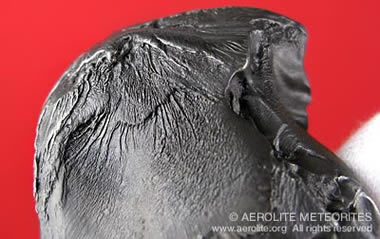
Oriented Sikhote-Alin: Detail of a remarkable 155.7-gram oriented Sikhote-Alin specimen. During flight, the leading edge maintained a fixed orientation towards our planet, resulting in the snub-nosed or bullet shape which is typical of highly oriented meteorites. Note the tendril-like features where rivulets of molten iron flowed across the surface. Photograph by Leigh Anne DelRay, copyright Aerolite Meteorites. Click to enlarge.
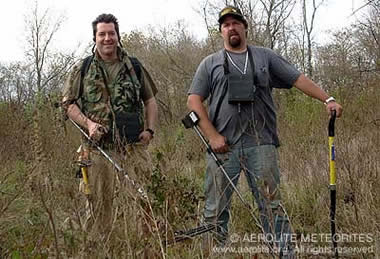
Meteorite hunting in Texas: The author [above left] and his friend and expedition partner, Steve Arnold, hunting for iron meteorites with specialized metal detectors in Red River County, Texas. Meteorites are known to have fallen in the area, which is also an old farming community. The overgrown terrain coupled with ground rich in discarded farm implements and man-made iron materials made meteorite hunting a real challenge. Photograph by McCartney Taylor, copyright Aerolite Meteorites. Click to enlarge.
Some Famous Iron Meteorites
CANYON DIABLO
Coconino County, Arizona, USA
First discovered 1891
IAB, coarse octahedrite
About 25,000 years ago a building-sized iron meteorite crashed into the desert between the present-day towns of Flagstaff and Winslow in northern Arizona. The size and inertia of the impactor resulted in a massive explosion which excavated a crater almost 600 feet deep and 4,000 feet in diameter.
Research conducted by the seminal meteorite scientist H.H. Nininger revealed that a large part of the original mass vaporized upon impact, while hundreds of tons of fragments fell around the crater within a radius of several miles. The site is erroneously named Meteor Crater (craters are formed by meteorites, not meteors) and is generally regarded as the best preserved impact site on earth. Iron meteorites are still occasionally found around the crater, but the surrounding land is privately owned and, unfortunately, meteorite collecting is prohibited. The meteorite takes its name from a steep-sided canyon situated west of the crater.
| Meteorwritings Menu |
WILLAMETTE
Clackamas County, Oregon, USA
Discovered 1902
IIIAB, medium octahedrite
The 15-ton Willamette iron is considered by many to be the most beautiful and spectacular meteorite in the world. It was discovered in 1902 on land owned by the Oregon Iron and Steel Company near the village of Willamette (today part of the city of West Linn). The finder, Mr. Ellis Hughes, together with his fifteen year-old son discretely moved the huge iron almost a mile, onto his own land, using an ingenious hand made wooden cart. Hughes was later successfully sued by the steel company, with ownership of the meteorite being awarded to them.
In 1906 the meteorite was purchased, reportedly for $20,600, and donated to the American Museum of Natural History in New York. It was displayed in the Hayden Planetarium for many years, and can today be viewed in the Rose Center for Earth and Space.
Controversy has continued to follow the Willamette. The Confederated Tribes of the Grand Ronde Community of Oregon sued the American Museum of Natural History for the return of the Willamette, claiming it once belonged to the Clackamas tribe, and is a relic of historic and religious significance. In the year 2000, an agreement was reached stipulating that the Grande Ronde Community could "re-establish its relationship with the meteorite with an annual ceremonial visit."
SIKHOTE-ALIN
Primorskiy Kray, Russia
Witnessed fall, February 12, 1947
IIAB, coarsest octahedrite
In the winter of 1947 the largest documented meteorite event took place near the Sikhote-Alin mountains in eastern Siberia. Thousands of fragments fell among snow-covered trees, and formed an extraordinary crater field comprised of 99 separate impact structures. There are two distinct types of Sikhote-Alin meteorites: individuals which flew through the atmosphere on their own, often acquiring regmaglypts and orientation; and angular shrapnel fragments which exploded as a result of atmospheric pressure. Sikhote-Alin individuals typically melted into unusual sculptural shapes in flight, are among the most attractive iron meteorites, and are much coveted by collectors.
Geoff Notkin's Meteorite Book
|
About the Author
|
Geoffrey Notkin is a meteorite hunter, science writer, photographer, and musician. He was born in New York City, raised in London, England, and now makes his home in the Sonoran Desert in Arizona. A frequent contributor to science and art magazines, his work has appeared in Reader's Digest, The Village Voice, Wired, Meteorite, Seed, Sky & Telescope, Rock & Gem, Lapidary Journal, Geotimes, New York Press, and numerous other national and international publications. He works regularly in television and has made documentaries for The Discovery Channel, BBC, PBS, History Channel, National Geographic, A&E, and the Travel Channel.
Aerolite Meteorites - WE DIG SPACE ROCKS™
| More Meteorites |
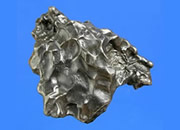 |
What Are Meteorites? |
 |
Extraterrestrial Gems |
 |
Gifts That Rock |
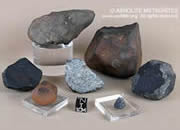 |
Collecting Meteorites |
 |
Moldavite |
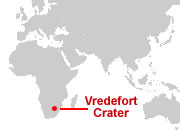 |
The Vredefort Crater |
 |
Mars Meteorites |
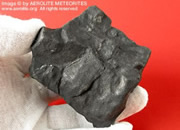 |
Meteorite Identification |

Find Other Topics on Geology.com:

|

| ||

|

| ||

|

| ||

|

|

